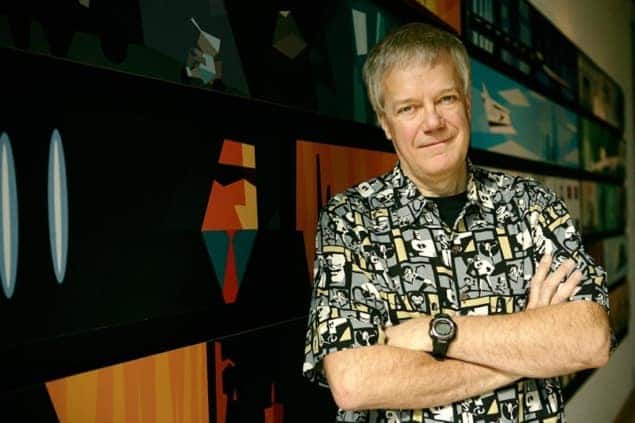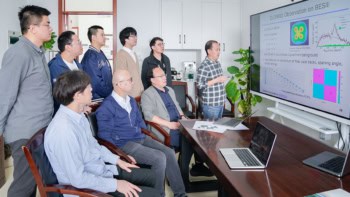Rob Cook is vice-president of advanced technology at Pixar Animation Studios. In 2001 he won an Oscar for “significant advancements to the field of motion-picture rendering” for co-creating the RenderMan animation software

Why did you decide to study physics?
I became interested in it in high school when I read a book on relativity. I thought it was the most fascinating thing around, and I was hooked.
How did you get into computer graphics?
After I graduated from Duke University in 1973, I was not sure what I wanted to do. However, I had learned to program computers as part of a lab course, so I found a job at the Digital Equipment Corporation in Massachusetts. There was one person there who was doing computer graphics, but he was actually more interested in medical databases, so I said I would do graphics instead. After I got into it, I thought “This is great, this is what I want to do”, so I went to Cornell University to get a Master’s in computer graphics.
How did you get involved in film?
At that time, images that were made using computer graphics looked really artificial, like plastic, and nobody knew why. It turned out that the model they were using for light reflecting off surfaces was just something someone had made up – it was not based on physics at all. So for my thesis, I used a different model that included the physics of how light reflects off surfaces. The results looked really good: I was able to simulate particular types of materials and really get control over the appearance of the surface. That caught the attention of Lucasfilm, which was just setting up a computer-graphics division, and it hired me.
What inspired you to develop RenderMan?
When you look around, you notice that most things are not just made of one material such as bronze or ivory. They are more complex than that: they have multiple materials, they are beaten up, they have scratches. We needed to give artists control over those surface appearances, so I worked on something called programmable shading that uses equations to describe how a surface looks, but also builds a framework over them to allow artists to make really complex, rich surfaces. That is at the heart of what we do with RenderMan, and over the last 16 years, every film nominated for visual effects at the Academy Awards has used it.
How has your training in physics helped you?
Aside from my thesis work, it also helped when we were developing RenderMan. In computer graphics, you have a virtual camera looking at a virtual world, and for special effects you want to match this with live-action footage. But for it to look convincingly real, you have to get the characteristics of your virtual camera to match those of the physical camera. That turns out to be hard for a number of reasons. One is something called “motion blur”: when a physical camera takes a picture, it opens the shutter and a certain amount of time goes by before it closes. During that time, things move, and this causes the image to blur. This blur turns out to be really important for making the motion look smooth, so you have to simulate it in the renderer.
Another thing you have to simulate is the aperture of the lens – the light is not entering the camera in one spot, but all over the lens, and that gives you depth of field. You need to simulate both blur and lens effects, but that means that not only are you integrating the scene around each pixel, you also have to integrate that pixel over time and over the lens and over other things. You end up with this incredibly complex integral, and it turns out that there is a technique in physics called Monte Carlo integration that is perfectly suited to dealing with it.
However, none of this stuff was in the undergraduate curriculum – I had to learn it on my own later. What physics really taught me was how to think about things in a creative and rigorous way. It taught me how to think about hard problems.
Are there other ways that physics is used in animation?
At Pixar, we use physics a lot to simulate the motion of complex things like clothes or hair. But you have to remember that in the animated world, animators do wacky things. They exaggerate enormously in order to tell the story, so the physics has to be reworked so that it can apply to this very non-physical cartoon world. For example, in Monsters Inc there is a scene where Mike is training Sulley to scare twins in a bunk bed. As Sulley is popping from the top to the bottom, there are several g‘s worth of force on his hair! In the animated world, you can do that, because it looks better. These are the sorts of effects that make us love animation.
What would you like to be able to do with computer graphics that you cannot do now?
One thing that remains a challenge is a simulated human. We have come a long way, but it is hard because our brains are wired to perceive other humans. If the simulated person looks cartoony, we are willing to accept it not being perfect, but as things get more realistic, a part of our brain that responds to people gets involved and then we are very picky about what we see: if things look a little off, they look creepy. That is a challenge, but I think we are almost there.
Any advice for today’s physics students?
I always advise people to do something they really love because you are likely to be better at it and you are going to spend a lot of time doing it, so it should be something you genuinely enjoy. I think it is a mistake to decide “I’m going to go into this even though I don’t really like it that much because I think it’s going to be a good career”. It is your life, and you want to spend it doing something you love.



